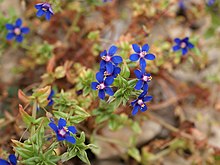Lysimachia foemina
Lysimachia foemina | |
|---|---|
 | |
Lysimachia foemina | |
Scientific classification | |
| Kingdom: | Plantae |
| (unranked): | Angiosperms |
| (unranked): | Eudicots |
| (unranked): | Asterids |
| Order: | Ericales |
| Family: | Primulaceae |
| Genus: | Lysimachia |
| Species: | L. foemina |
Binomial name | |
Lysimachia foemina Mill. | |
Synonyms | |
| |
Lysimachia foemina (commonly known as Poorman's Weatherglass and formerly known as Anagallis foemina) is a low-growing annual herbaceous plant of the genus Lysimachia belonging to the Primulaceae family. In a comparison of DNA sequences, L. foemina was shown to be most closely related to L. monelli.[1] It had been thought by many to be closest to L. arvensis, and some authors had even included L. foemina as a subspecies of L. arvensis.[citation needed] The three species were among several transferred from Anagallis to Lysimachia in a 2009 paper.[2]
Contents
1 Etymology
2 Description
3 Distribution
4 Habitat
5 References
6 External links
Etymology
The previous genus name Anagallis derives from the Greek words ana meaning "again" and agallein meaning "to delight in", possibly referring to the fact that these plants produce flowers twice in a year and the flowers open whenever the sun strikes them.[3] The species epithet foemina means "female" and refers to the small size of the plant and the gentleness of its appearance. The common name refers to the fact that the flowers close at the approaching of the bad weather.[4]
Description
Lysimachia foemina has weak, square and sprawling stems growing to about 5–18 centimetres (2.0–7.1 in) long,[5] which bear bright green sessile leaves in opposite pairs. The leaves are usually lance-shaped about 7–11 mm (0.28–0.43 in) wide and 12–16 mm (0.47–0.63 in) long, although some leaves, especially the lowest, may be ovate.
The small flowers are about 8 mm (0.31 in) in diameter, have a short stalk, are produced in the leaf axils and are usually blue. They have five lanceolate sepals and five petals. The filaments are about 3 mm (0.12 in) long, with showy yellow anthers. The flowering period extends from April to October.[5] The hermaphroditic flowers are pollinated by insects (entomogamy). The fruit is a spherical capsule up to 4 mm (0.16 in) in diameter containing about 15 seeds.[5]
This species should not be confused with the related Lysimachia arvensis. In 2007, a molecular phylogenetic study showed that Lysimachia foemina is more closely related to Lysimachia monelli than to Lysimachia arvensis, and should be treated as a separate species.[1]
Lysimachia foemina can be distinguished from Lysimachia arvensis on the basis of the hairiness and arrangement of the petals and by the length of the flower stalk. In fact this species has just a few glandular hairs on the margin of the petals, clearly separated one from another (never imbricate). Furthermore the flower stalk is shorter (up to 1 cm). The colour of the flowers is not a diagnostic character.[5]
Distribution
This cosmopolitan plant is native to central and southern Europe and has been introduced in Africa, northern and eastern Asia, North and South America and western Australia.[5]
Habitat
It grows in scrub, uncultivated soils and grasslands. It prefers dry, nutrient- and lime-rich soils, at an altitude of 0–1,200 metres (0–3,937 ft) above sea level.[5]
References
^ ab Manns, Ulrika; Anderberg, AA (Dec 2007). "Relationships of Anagallis foemina and Anagallis arvensis (Myrsinaceae): New insights inferred from DNA sequence data". Molecular Phylogenetics and Evolution. PubMed. 45 (3): 971–980. doi:10.1016/j.ympev.2007.07.022. PMID 17869544..mw-parser-output cite.citation{font-style:inherit}.mw-parser-output q{quotes:"""""""'""'"}.mw-parser-output code.cs1-code{color:inherit;background:inherit;border:inherit;padding:inherit}.mw-parser-output .cs1-lock-free a{background:url("//upload.wikimedia.org/wikipedia/commons/thumb/6/65/Lock-green.svg/9px-Lock-green.svg.png")no-repeat;background-position:right .1em center}.mw-parser-output .cs1-lock-limited a,.mw-parser-output .cs1-lock-registration a{background:url("//upload.wikimedia.org/wikipedia/commons/thumb/d/d6/Lock-gray-alt-2.svg/9px-Lock-gray-alt-2.svg.png")no-repeat;background-position:right .1em center}.mw-parser-output .cs1-lock-subscription a{background:url("//upload.wikimedia.org/wikipedia/commons/thumb/a/aa/Lock-red-alt-2.svg/9px-Lock-red-alt-2.svg.png")no-repeat;background-position:right .1em center}.mw-parser-output .cs1-subscription,.mw-parser-output .cs1-registration{color:#555}.mw-parser-output .cs1-subscription span,.mw-parser-output .cs1-registration span{border-bottom:1px dotted;cursor:help}.mw-parser-output .cs1-hidden-error{display:none;font-size:100%}.mw-parser-output .cs1-visible-error{font-size:100%}.mw-parser-output .cs1-subscription,.mw-parser-output .cs1-registration,.mw-parser-output .cs1-format{font-size:95%}.mw-parser-output .cs1-kern-left,.mw-parser-output .cs1-kern-wl-left{padding-left:0.2em}.mw-parser-output .cs1-kern-right,.mw-parser-output .cs1-kern-wl-right{padding-right:0.2em}
^ Manns, Ulrika; Anderberg, Arne A. (July 2009). "New combinations and names in Lysimachia (Myrsinaceae) for species of Anagallis, Pelletiera and Trientalis". Willdenowia. 39 (1): 49–54. doi:10.3372/wi.39.39103. JSTOR 20699148.CS1 maint: Uses authors parameter (link)
^ Malta Wild Plants
^ Trek Nature
^ abcdef Pignatti S. - Flora d'Italia – Edagricole – 1982. Vol. II, pag. 291
| Wikimedia Commons has media related to Lysimachia foemina. |
Wikispecies has information related to Lysimachia foemina |
External links
- Biolib
- Schede di botanica
- Cretanvista